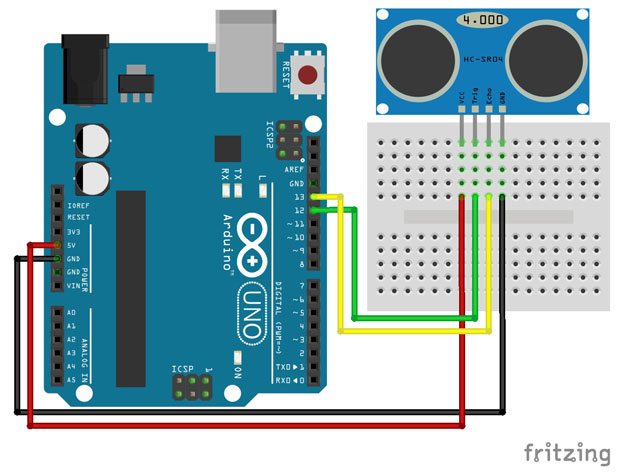Minimalist library for ultrasound module to Arduino
Work with ultrasonic modules is fairly simple, but can be even more practical if you abstract the control of some features. This library aims to resource efficiency and to simplify access to data.
Where necessary use the ultrasonic module HC-SR04 (one of the most common on the market), Ping))) and/or Seeed SEN136B5B (from Seeed Studio), there are hundreds of libraries that purport to provide the most diverse roles for the user, however, the vast majority of the time, we just need to find out the distance and is that's what does this library.
This library is minimalist, reduces code execution, validation and unnecessary use of global variables, prioritizing smaller data types.
It is very easy to connect an ultrasound module to the Arduino. For example, if you are using HC-SR04, connect the trigger and echo pin module on pin 12 and 13 of the Arduino, respectively. As in the picture:

If you are using a module with three pins (like Ping))) or Seeed SEN136B5B), you can conect the sig pin module on pin 13 of the Arduino.
You can use the Fritzing(.fzz) files inside extras to draw your prototypes.
The idea is to provide a simpler environment possible. To do this, simply follow the steps:
-
Installing
First you need to import the library so that the IDE recognizes it. The simplest way is importing through the IDE itself:
- Click in
Sketch > Include Library > Manage Libraries...; - In the search field type:
ultrasonic; - In the list, look for
Ultrasonic by Erick Simões; - Click on
Install.
Alternatively, you can download the library here and import the
.zipfile into the IDE (see how to import a library here). - Click in
-
Importing on code
To import the library to your code, just write at the beginning of the code
#include <Ultrasonic.h>or, in the Arduino IDE, click inSketch > Include Library > Ultrasonic(will have the same result). -
Starting (the most exciting part)
Now is simply create a variable of type Ultrasonic passing as parameters two values representing, respectively, the Trig (emitter) and Echo (receiver) pins. Like this:
Ultrasonic ultrasonic(12, 13);
If you are using a module with three pins (like Ping))) or Seeed SEN136B5B), pass as a parameter only the signal pin. Like this:
Ultrasonic ultrasonic(13);
-
Discovering the distance
Having initialized a variable, you can run hers from the method that returns the distance read by module Ultrasonic:
read():ultrasonic.read()
-
Only this?
Yes. That's it. By default, the value returned from the function
read()is the distance in centimeters. -
Seriously?
You can still do a little more determining the unit of measurement that will be returned (centimeters (CM) or inches (INC)).
ultrasonic.read() // distance in CM ultrasonic.read(CM) // distance in CM ultrasonic.read(INC) // distance in INC
You can also use more than one ultrasound module:
ultrasonic ultrasound1(12, 13); ultrasonic ultrasound2(10, 11); ultrasonic ultrasound3(5);
-
Timeouts
If there is no object in range, the library will lock-up as it waits for the return pulse. You can change how long to wait by setting a timeout (in microseconds) in the constructor:
Ultrasonic ultrasonic(12, 13, 40000UL);
Or during runtime:
ultrasonic.setTimeout(40000UL);Using a 40ms timeout should give you a maximum range of approximately 6.8m. You may need to adjust this parameter.
See the examples here.
Ultrasonic by Erick Simões is licensed under a MIT License. Based on the work of Carl John Nobile available here. Feel free to contact the author on Twitter: @AloErickSimoes
See LICENSE for details.

